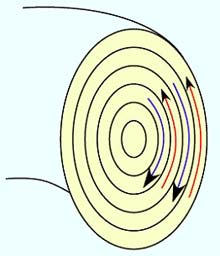Turbulence Restrains Itself

Theoretical picture of self-generated turbulence flows in a tokamak cross section
Like rapidly flowing gases and liquids, magnetically confined plasmas in tokamaks and related fusion devices exhibit a high degree of turbulence, which can generally destroy the optimal conditions for producing fusion energy. In a deeply encouraging new result, scientists have experimentally confirmed that turbulence can actually limit its own ability to wreak havoc.
Researchers at the DIII-D tokamak at General Atomics have discovered that turbulence generates its own flows that act as a self-regulating mechanism. These flows, which are predicted theoretically and have been observed in computer simulations, create a “shearing” or tearing action that destroys turbulent eddies, as indicated by the figure. Such flows are like the large-scale zonal jets and patterns seen in the atmospheres of Jupiter and other large planets.
These turbulent flows have been clearly observed in recent experiments at DIII-D by using a special imaging system. The imaging measurements are obtained at a rate of one million frames per second and have a spatial resolution of about 1 cm. Observing and identifying these unique turbulence flows experimentally, and comparing their characteristics with theory, is helping to advance researchers’ understanding of this complex and crucial phenomena taking place in high temperature fusion plasmas.
The roiling turbulence inside tokamaks represents some of the most complex physics on the planet. Using the full power of the world’s largest supercomputers, scientists in separate work have now been able to fully simulate the movement of tokamak particles and heat due to turbulence. Implementing new algorithms to incorporate very complex physics, they included the effects of super-fast electrons and the recent practice of rotating the plasma, like horses in a merry go round, for higher-pressure tokamak operation and higher-energy output. Making it possible to directly compare DIII-D turbulence experiments with numerical calculations for the first time, these simulations may also help greatly in making reliable predictions for larger tokamaks and future commercial-scale fusion reactors.
Contacts
D-III experiments:
A collaboration between the University of Wisconsin-Madison, and the DIII-D National Fusion Facility at General Atomics.
George R. McKee, (858) 455-2419, mckee@fusion.gat.com
Raymond J. Fonck, University of Wisconsin-Madison, General Atomics
Supercomputer simulations:
Jeff Candy, General Atomics, (858) 455-2593, jeff.candy@gat.com
Media Contact
All latest news from the category: Physics and Astronomy
This area deals with the fundamental laws and building blocks of nature and how they interact, the properties and the behavior of matter, and research into space and time and their structures.
innovations-report provides in-depth reports and articles on subjects such as astrophysics, laser technologies, nuclear, quantum, particle and solid-state physics, nanotechnologies, planetary research and findings (Mars, Venus) and developments related to the Hubble Telescope.
Newest articles

First-of-its-kind study uses remote sensing to monitor plastic debris in rivers and lakes
Remote sensing creates a cost-effective solution to monitoring plastic pollution. A first-of-its-kind study from researchers at the University of Minnesota Twin Cities shows how remote sensing can help monitor and…

Laser-based artificial neuron mimics nerve cell functions at lightning speed
With a processing speed a billion times faster than nature, chip-based laser neuron could help advance AI tasks such as pattern recognition and sequence prediction. Researchers have developed a laser-based…

Optimising the processing of plastic waste
Just one look in the yellow bin reveals a colourful jumble of different types of plastic. However, the purer and more uniform plastic waste is, the easier it is to…


